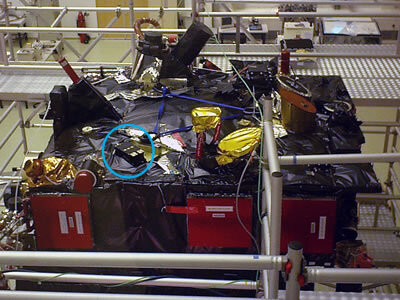Rosetta monitors Van Allen belt during Earth swing-by
ESA's Rosetta spacecraft performed an Earth swing-by on 13 November 2007. One of the instruments on board Rosetta, the Standard Radiation Environment Monitor (SREM), measured the energetic particle activity in the Earth’s radiation belts as the spacecraft passed through it.
In order for Rosetta to reach and rendezvous with its target comet, the spacecraft has to gain a lot of velocity. Swing-by manoeuvres are the only way to gain the required amount of energy. Multiple planetary swing-bys are being used to accelerate Rosetta so as to eventually match the velocity of the target comet.
The recent swing-by was the second of three around the Earth, with one swing-by also having been performed around Mars. At its closest approach, Rosetta passed 5 295 km from the Earth’s surface, travelling at around
SREM - Standard Radiation Environment Monitor

The Standard Radiation Environment Monitor (SREM) was developed and manufactured by Contraves Space AG, now Oerlikon Space AG (CH), in cooperation with the Paul Scherrer Institut (CH) under a contract with ESA.
SREM performs a wide range of radiation monitoring and alert functions during its host spacecraft’s mission and downloads the results via the spacecraft telemetry system to a user on ground. It is designed as a standard item of equipment, compatible with all common spacecraft interfaces and mission constraints.
The Space Environments and Effects Section of the Electromagnetics and Space Environments Division, together with the Radiation Effects Section of the Components Division, both within ESA’s Directorate of Technical and Quality Management, facilitate the incorporation of radiation monitoring on ESA spacecraft. Measurement of the radiation environment experienced by a spacecraft is important because exposure to energetic particles can lead to interference and anomalies in systems and payloads, can damage electronic components such as integrated circuits or degrade the performance of sensors and solar generators.
SREM has flown on Proba-1 and Integral, as well as Rosetta. It is scheduled to fly on GIOVE-B, Herschel and Planck. Of the spacecraft already launched, Rosetta is the only mission to have travelled beyond Earth orbit.
Detecting Earth’s radiation belts

The Earth’s radiation belts (Van Allen belts) are torus shaped regions of energetic charged particles surrounding the Earth and held in place by Earth's magnetic field.
The inner of these belts extends to an altitude of about 6 000 km above the Earth's surface at the equator, and contains high concentrations of protons with energies in the range 10 to several hundred MeV.
Further out, with its peak intensity at an altitude somewhere between 15 000 and 20 000 km and extending beyond geostationary orbit, is a highly variable region populated mainly by electrons with energies between 0.1 and 10 MeV.
The plot of SREM count rates versus time, which can be enlarged by clicking on it, shows two main peaks. Initial analysis has concluded that these were caused by two passages through the outer radiation belt.
| SREM channel properties | |||
| Channel | Particle | Min energy (MeV) | Max energy (MeV) |
| TC1 | Proton | 20 | ∞ |
| Electron | 2 | ∞ | |
| S12 | Proton | 20 | 550 |
| Electron | ~2 | ∞ | |
| S13 | Proton | 20 | 120 |
| Electron | ~2.2 | ∞ | |
| S14 | Proton | 20 | 27 |
| S15 | Proton | 20 | 34 |
The correlation between detectors TC1 (total count – protons above 20 MeV and electrons above 2 MeV) and S12 (protons 20 to 550 MeV, electrons above ~2 MeV), combined with the matching lower peaks for S13 (protons 20 to 120 MeV, electrons above ~2.2 MeV) and the absence of activity in channels S14 and S15 (protons 20 to 27 MeV and protons 20 to 34 MeV, respectively, with very low sensitivity to electrons) indicates the detected particles were mainly electrons in the MeV range , consistent with passage through the outer radiation belt. The peaks occur either side of closest approach, which happened at 20:57 UTC.
While the primary purpose of SREM on Rosetta is to monitor the radiation dose received by the spacecraft, the swing-by offered an interesting chance to use the instrument for additional experimentation.
For further information, contact Petteri Nieminen, (Space Systems Senior Analyst, Space Environments and Effects Section, ESA-ESTEC).
![]()




